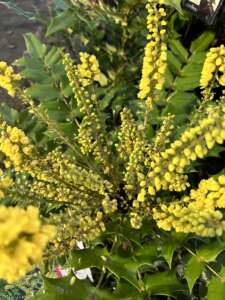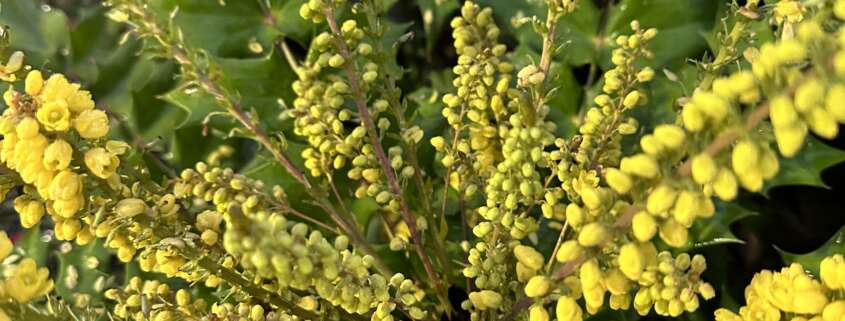Winter plants, mahonia
Winter plants are not numerous, but they are remarkable, especially if the flowers appear in the gray days of December and January.
We start the series with Mahonia, a pretty shrub with yellow flowers.
The Mahonia
It belongs to the genus Mahonia, which is part of the Berberidaceae family.
Mahonia, part of winter plants, is native to Asia, North America and Central America. There are different species distributed in these regions.
One of the most common species is Mahonia aquifolium, also known as Golden Ear Spruce.
It is one of the most widespread varieties. It is native to North America and is valued for its dark green, spiny, evergreen leaves and clusters of fragrant yellow flowers in winter and early spring.
Native to Japan, Mahonia japonica is also valued for its evergreen leaves, but it tends to be a little less spiny than Mahonia aquifolium. Its yellow flowers appear in winter or early spring.
Native to China Mahonia bealei is often grown for its evergreen leaves and clusters of yellow flowers in winter.
Each of these varieties may have specific characteristics in terms of size, leaf shape and flowering, but they are generally valued for their ability to add color to the garden during the winter months.

mahonia
How does it grow?
Mahonia prefers well-drained and fertile soil. It can tolerate a range of soil types, but it thrives best in slightly acidic to neutral soil.It prefers a partially shaded location, although some varieties can tolerate some sun. Protection from strong winds is often beneficial.Most Mahonia varieties are cold hardy. In fact, their ability to flower in winter makes them ideal for gardens with low winter temperatures.Mahonia adult size depends on the specific variety and growing conditions. In general, most Mahonias reach a mature height of around 1 to 3 meters.Some varieties, like Mahonia aquifolium, tend to stay smaller, usually reaching between 1 and 2 meters in height.Other varieties, such as Mahonia japonica, can sometimes reach up to 3 meters or more.
The biggest and the smallest
Winter plants Mahonia ‘Charity’ is a variety that can reach a significant size, sometimes up to 3 meters in height. And we love its beautiful flowering!Mahonia eurybracteata ‘Soft Caress’ is a more compact variety, usually reaching a height of around 1 to 1.2 meters. It has thinner, less spiny leaves than some other varieties.In summary, it is a solid plant. Most varieties are resistant to light frosts and can withstand temperatures as low as -15°C to -20°C.And as the foliage is evergreen, you are sure to provide a winter decor with yellow flowers, even in the most difficult areas of our country. Nice, right?
And the berries?
After flowering, it is the berries that interest us, for the decoration, but also for the taste side, in fact, the birds love them!Yes, Mahonia berries are edible and are sometimes used in the preparation of jams, jellies and other food products. However, the taste can vary from one species to another, and some people may find them slightly bitter. The berries of the most common Mahonia aquifolium are generally considered edible.
And how to eat them?
They can be used to make jams or jellies. It is often recommended to mix them with other sweeter fruits to balance their flavor. You can follow a standard jam recipe, adding sugar and pectin as directed.You can also make infusions. Steep them in hot water to create a flavored drink. Some people also add honey to sweeten the taste.Mahonia berries can be used as a decorative element. They add an interesting touch of color to dishes or desserts.Watch out for unripe berries: Be sure to only eat ripe berries, as unripe berries can be slightly toxic. If you are unsure about the variety of Mahonia you have, find out more about its edibility.Before consuming Mahonia berries or using them in recipes, it is recommended that you check reliable sources to ensure they are safe for consumption, especially if you have concerns about allergies or adverse reactions.




Leave a Reply
Want to join the discussion?Feel free to contribute!